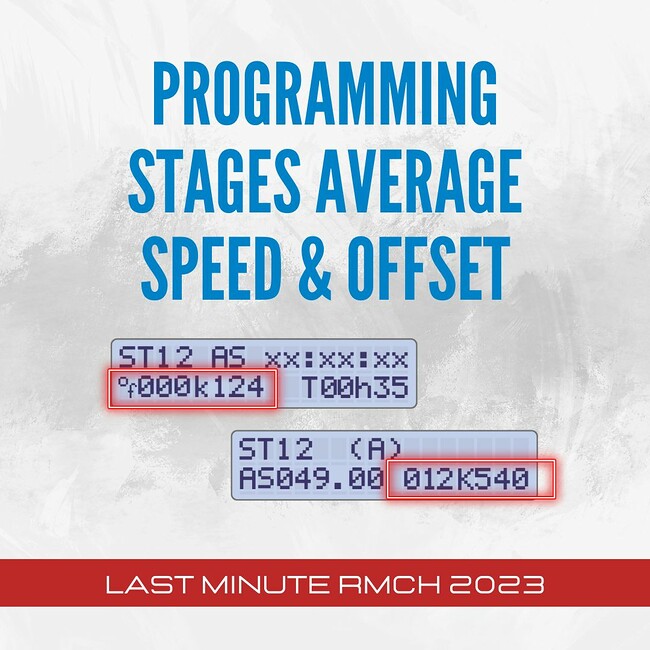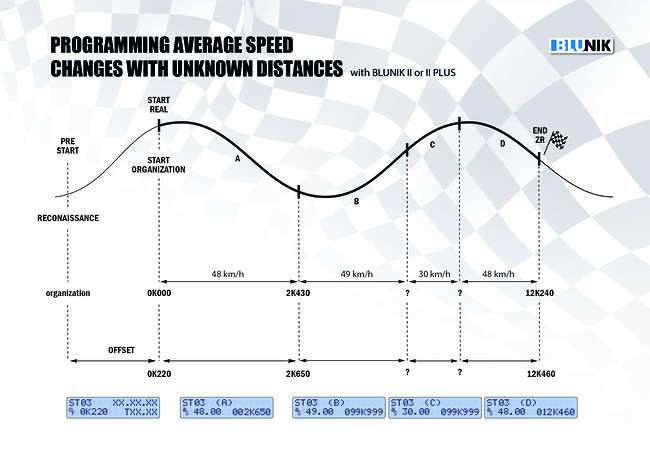Schedule media changes when we use the Offset function.
Average changes in sections Rally Monte Carlo Historique 2023.
Are you near to start the Rally Monte Carlo Historique 2023 and perhaps you have new information about media changes during the stage?
Do you use the offset function for different starting points and you have questions about how to program average speeds?
Have you considered using the "average speed changes with external reference" function detailed in manual section 6.18?
Here we explain the combination of the Offset function, average speed changes at known distances and average speed changes at unknown distances.
THE OFFSET FUNCTION
The offset function is used when the starting point of our reconnaissance roadbook is different from the starting point of the organization.
The distance between our "pre-start" and the real start point is the offset distance.
You have more info in this high post. LINK.
When you enter offset, all Blunik devices does is start the stage time at the offset distance. In other words, only the total distance changes. It doesn't do anything else. It doesn't calculate anything, it doesn't modify anything.
AVERAGE SPEED AND OFFSET
In rallies such as the Rally Monte Carlo Historique 2023, the organizer gives you average spped changes to referenced distances at the start of the stage.
Something like: from the start up to 2,430Km regularity at 48,00Km/h, then change the average speed to 49Km/h until the entrance of a town where the Tripy device will tell you that you must go at 30Km/h, pass the town at 30Km/h until the Tripy indicates it again or maybe there will be a panel at the end of the slow zone and continue at 48.00Km/h until the end of the section.
The speeds of regularity to follow are clear.
But to go on time, and not arrive late or early, it is necessary to take into account the distances where the average speed changes.
The organizer will give you the distances referenced to the organizer's departure, it means the real departure on the day of the rally.
Instead you will probably go with the distance references of your recognitions. If so, it must be programmed consistently.
We will program the Blunik with the road book of our recognitions, so we will set the Offset distance (0K220 for example) to square the total distance of our Blunik with the total distance of our road book. In fact, we add the offset distance at the starting point. The org says 0K000 and our Blunik will say 0K220.
So do like this at each distance reference. If the organization tells us to change the average at 2,430Km, we will have to program it our blunik at 2,430Km+ offset, that is 2,650Km (as example)
TO PROGRAM THE AVERAGE SPEED PENDING THE STAGE
In fact, you will discover the distance of the average speed changing point when you are running the stage. The tripy will beep and tell you.
Some of you don't know, but Blunik allows you to change the programmation of the stage while you're doing the stage, so take advantage of it and set the average change distance when you know it.
When you change programmation while you are running the stage, the Blunik recalculates all what is needed when you exit the programming with the ENTER key.
Blunik recalculates all the ideal times from the start of the stage, so you can correct distances you have allready passed, average speeds and even the departure time. The fact is a very useful function to correct possible data entry errors.
Our advice is:
1) Prepare the programmation thinking about all the media changes and put the distance 99K999 where you don't know the distance at the average speed change.
2) At the real point of average speed change (where Tripy will indicate) you press "ZERO" to freeze the screen and you write down the total distance.
3) During a little while the pilot have to follow the new average speed with the speed indicator.
4) Reprogram the distance of average speed change. Press STAGE, change data and ENTER to exit.
AVERAGE SPEED CHANGES WITH EXTERNAL REFERENCE
Both Blunik II and Blunik II PLUS have the average speed change function with external reference, described in section 6.18 of the manual.
This function is very useful if there is no offset, but when there is an offset what it does when we press START is to take the total distance, subtract the offset and put it in the programmation.
So be careful! For the case of RMCH2023 it is not useful! (I hate to say it, but it's like this)
This is all. Remember to practice during some link to get confidence and that there is more detailed information in the manual.
Good luck and try to always respect the reduced speeds inside the towns.
More info:
- We always recommend verifying (and correcting if necessary) the schedule of the stage once you are inside the stage. You can verify and modify everything, departure time, offset distance, average speed change distances and the speeds to follow.
- You have more information in the manual Manual Blunik II PLUS section 3.3 page 19, 6.15 page 39, 6.16 page 40, 6.18 page 42 and 6.19 page 42
Everything we have explained applies to all versions of Blunik II and Blunik II PLUS.






